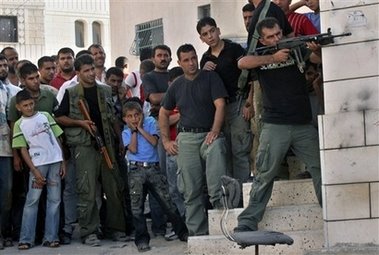The extraordinary buildup of European naval and military strength in and around Lebanon’s shores is way out of proportion for the task the European contingents of expanded UNIFIL have undertaken: to create a buffer between Israel and Hizballah.
Close investigation by DEBKAfile’s military and intelligence sources discloses that “Lebanese security” and peacemaking is not the object of the exercise. It is linked to the general anticipation of a military clash between the United States and Israel, on one side, and Iran and possibly Syria on the other, some time from now until November
This expectation has brought together the greatest sea and air armada Europe has ever assembled at any point on earth since World War II: two carriers with 75 fighter-bombers, spy planes and helicopters on their decks; 15 warships of various types – 7 French, 5 Italian, 2-3 Green, 3-5 German, and five American; thousands of Marines – French, Italian and German, as well as 1,800 US Marines.
It is improbably billed as support for a mere 7,000 European soldiers who are deployed in Lebanon to prevent the dwindling Israeli force of 4-5,000 soldiers and some 15-16,000 Hizballah militiamen from coming to blows as well as for humanitarian odd jobs.
A Western military expert remarked to DEBKAfile that the European naval forces cruising off Lebanese shores are roughly ten times as much as the UNIFIL contingents require as cover, especially when UNIFIL’s duties are strictly non-combat. After all, none of the UN contingents will be engaged in disarming Hizballah or blocking the flow of weapons incoming from Syria and Iran.
So, if not for Lebanon, what is this fine array of naval power really there for?
First, according to our military sources, the European participants feel the need of a strong naval presence in the eastern Mediterranean to prevent a possible Iranian-US-Israeli war igniting an Iranian long-range Shahab missile attack on Europe; second, as a deterrent to dissuade Syria and Hizballah from opening a second front against American and Israel from their eastern Mediterranean coasts.
Numbers alone do not do justice to the immense operational capabilities and firepower amassed opposite Lebanon. Take first the three fleet flagships.
From France’s nuclear-powered 38,000-ton Charles De Gaulle carrier, 40 Rafale M fighter craft whose range is 3,340 km can take off at intervals of 30 seconds. The ship also carries three E-2C Hawkeye surveillance craft. The combat control center of the French carrier can handle 2,000 simultaneous targets. The carrier leads a task fore of 7 warships carrying 2,800 French Marines.
Charles De Gaulle s also a floating logistics center operating water desalination plants for 15,000 men and enough food to feed an army for 90 days.
The USS Mount Whitney has the most sophisticated command and control suite in the world. Like the French Charles De Gaulle , it exercises command over a task force of 1,800 sailors, Marines, Air force medical and other personnel serving aboard the USS Barry, the USS Trenton , HSV Swift and USNS Kanawha .
Available to the fleet commander, US Vice Admiral J. “Boomer” Stufflebeem, formally titled commander of Joint Task Force Lebanon, is the uniquely advanced C41 command and intelligence system through which he can flash intelligence data to every American commander at any point between the eastern Mediterranean and the Persian Gulf and Iran. USS Mount Whitney communications are described as unsurpassed for the the secure transmission of data from any point to any other point in the world through HF, UHF,VHF, SHF and EHF.
The third carrier joining the other two is the Italian aircraft-helicopter carrier Garibaldi , which has launch pads for vertical takeoff by 16 AV-8B Harrier fighter-bombers or 18 Sikorsky SH-3D Seak King sea-choppers (or Italian Agusta Bell AB212 helicopters), designed to attack submarines and missile ships.
Military experts estimate that the Garibaldi currently carries 10 fighter planes and 6 helicopters.
The new European naval concentration tops up the forces which permanently crowd the eastern Mediterranean: the Italian-based American Sixth Fleet, some 15 small Israeli missile ships and half a dozen submarines and the NATO fleet of Canadian, British, Dutch, German, Spanish, Greek and Turkish warships. They are on patrol against al Qaeda (which is estimated to deploy 45 small freighters in the Mediterranean and Indian Ocean). The British have permanent air and sea bases in Cyprus.
This vast force’s main weakness, according to DEBKAfile’s military sources, is that it lacks a single unified command. A sudden flare-up in Lebanon, Syria or Iran could throw the entire force into confusion.
On paper, it has three commanders:
1. French General Alain Pellegrini is the commander of the expanded UNIFIL ground, naval and air force in Lebanon. In February 2007, he hands over to an Italian general who leads the largest of the European contingents of 3,000 men. It is hard to see France agreeing to place its prestigious Charles De Gaulle flagship under non-French command.
2. The American forces opposite Lebanese shores are under direct US command. Since the October 1993 debacle of an American peace force under the UN flag in Somalia, Washington has never again placed its military under UN command. (There is no American contingent in the UNIFIL ground force either.)
In other words, USS Mount Whitney , while serving the European fleets as their operational and intelligence nerve center will stay under the sole command of Vice Admiral Stufflebeem in all possible contingencies.
3. Similarly, the NATO fleet will remain under NATO command, and Israel’s air and naval units will take their orders from Israeli Navy Headquarters in Haifa and the General Staff in Tel Aviv.
The naval Babel piling up in the eastern Mediterranean may therefore find itself at cross purposes when action is needed in an armed conflict. Iran, Syria and Hizballah could be counting on this weakness as a tactical asset in their favor.

